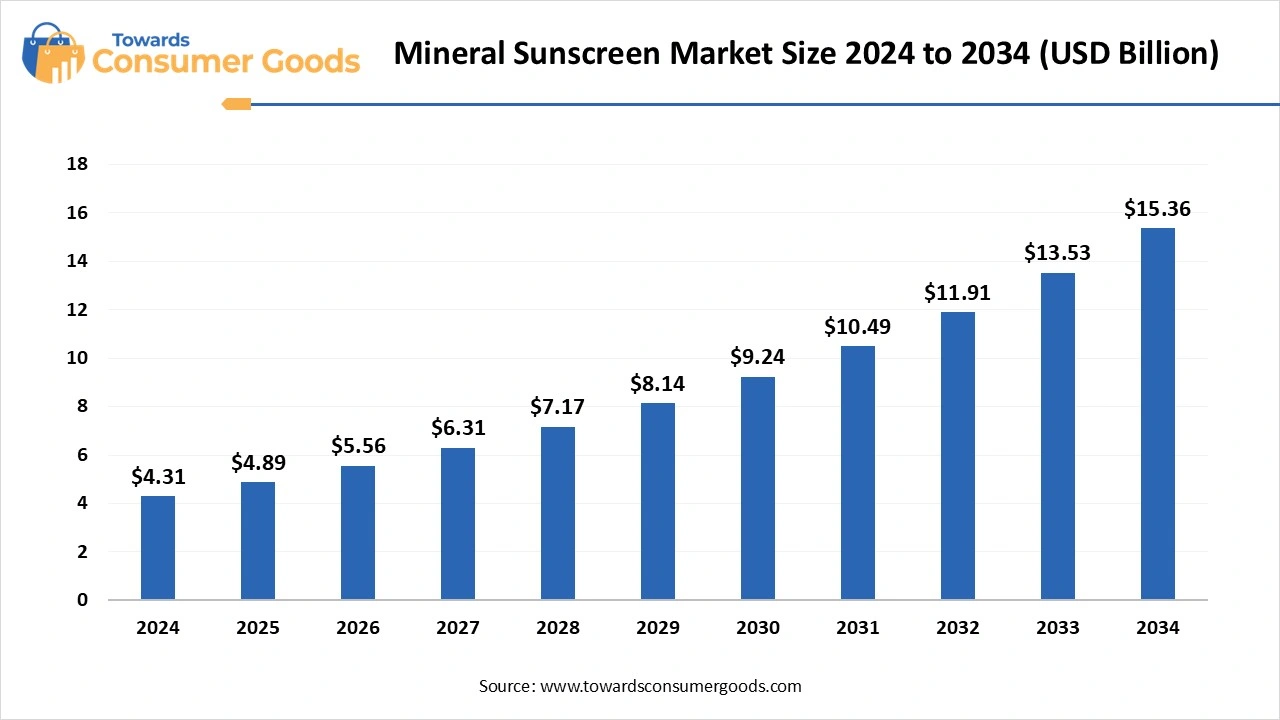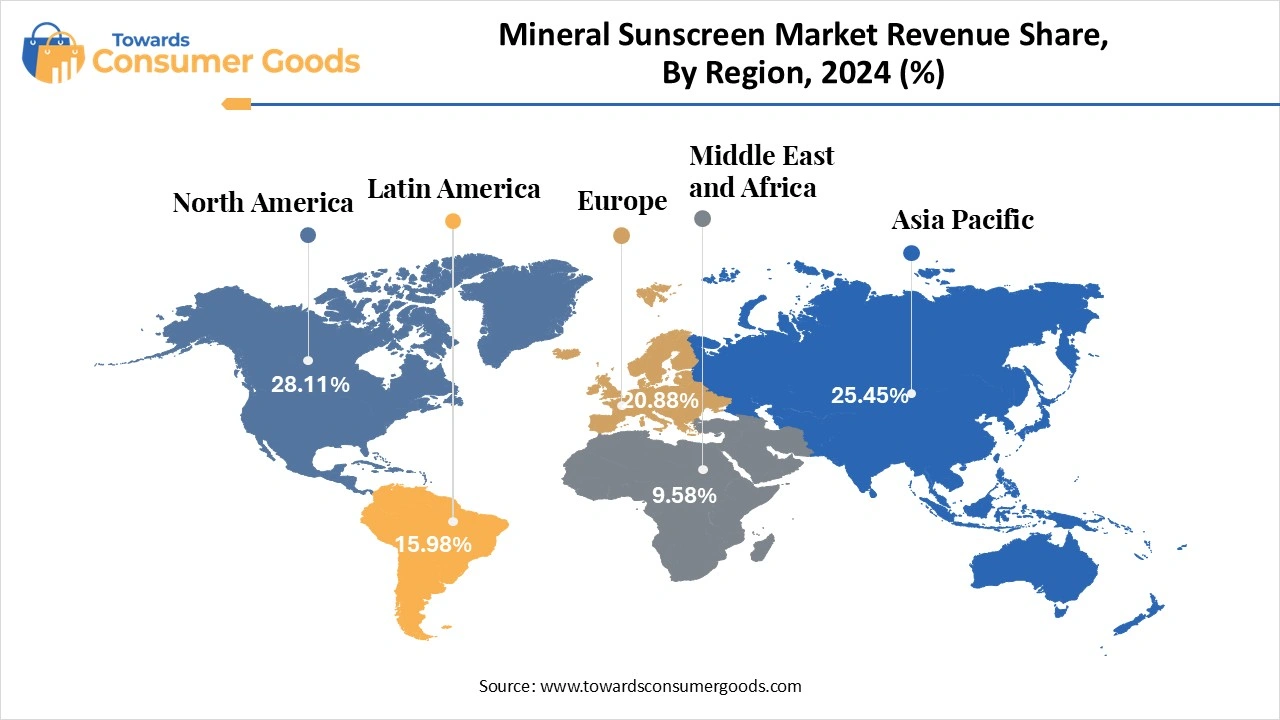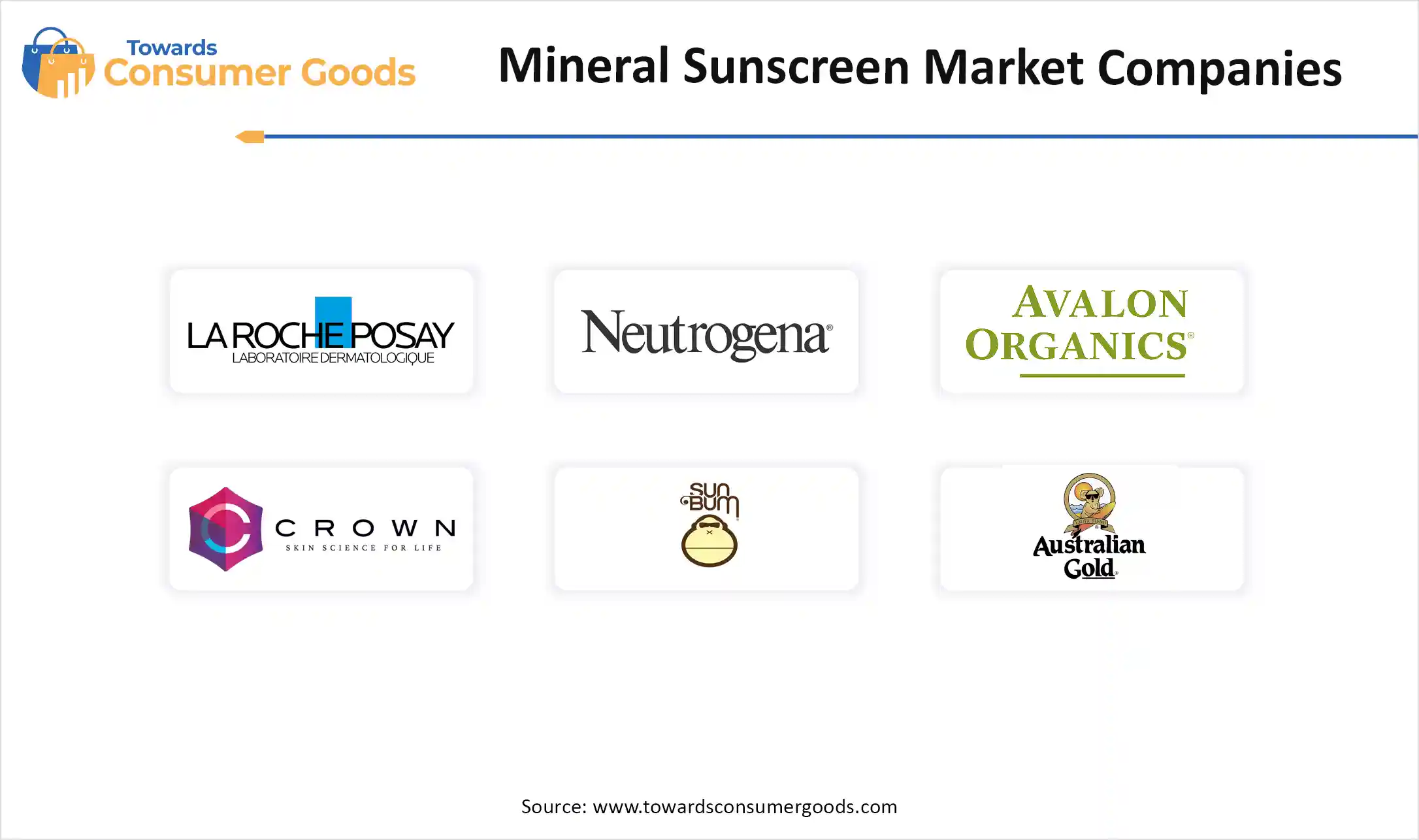July 2025
The mineral sunscreen market accounted for USD 4.31 billion in 2024 and is expected to reach around USD 15.36 billion by 2034, with a CAGR of 13.55% from 2025 to 2034. The demand for reef-safe products has increased due to regulatory initiatives and consumer awareness, driving the global mineral sunscreen market. Growing consumer preference for natural and organic ingredients in skincare products is fostering the adoption of mineral-based sunscreens.

The global mineral sunscreen market has witnessed spectacular growth, driven by factors like increased skin health awareness, education regarding harmful UV rays, and skin cancer. The participation in outdoor activities has increased, driving the need for effective and innovative skin care and protective products. Additionally, the rising surge for natural and organic products is shifting consumers from chemical sunscreens to mineral sunscreens. Regulatory support for reef-safe products and investments in sustainable innovations are propelling market growth.
The rise in awareness regarding the harmful effects of UV radiation is the major driver for the global mineral sunscreen market. The concern about skin cancer has also increased, driving an essential need for effective sun protection products. People are being conscious about preventive care, including protecting their skin from UV radiation. Social media and influencers are promoting awareness about skin health and the advantages of mineral sunscreen products, which are playing a significant role in the demand for natural and organic products. Government and health organizations are launching campaigns to educate consumers about the risk of UV radiation and the importance of sun protection.
Neutrogena and its partner John Cena launched the campaign promoting its Ultra Sheer Face Liquid Mineral Sunscreen SPF 70 on March 31, 2025. The campaign targeted the importance of sun protection, using Cena's famous "You Can't See Me" catchphrase to highlight the sunscreen's lightweight and invisible finish.
| Report Attributes | Details |
| Market Size in 2025 | USD 4.89 Billion |
| Expected Size by 2034 | USD 15.36 Billion |
| Growth Rate | CAGR of 13.55% |
| Base Year in Estimation | 2024 |
| Forecast Period | 2025-2034 |
| Dominant Region | North America |
| Segment Covered | By Product , By Form, By Skin Type, By SPF Range, By End-user, By Distribution Channel, By Region |
| Key Companies Profiled | Neutrogena, Avalon Natural Products Inc., Australian, Gold, EltaMD, un Bum, La Roche-Posay, Johnson & Johnson Consumer Inc., Coppertone, Goddess Garden, Edgewell |
Development of Convenient Product
Consumers are buying convenient products like sprays, sticks, and tinted formulas. These formulas make it easier for the application. The increased use of sunscreens for babies is further driving the need for convenient formats of mineral sunscreen products. Mineral sunscreens are popular for targeted areas like the face and nose, due to their portability and mess-free applications. The new trend of on-the-go use products has the potential to attract new consumers toward mineral sunscreens. Companies are heavily investing in the development of convenient products with more effectiveness, a gentle and eco-friendly nature. Companies' efforts in the development of innovative, convenient products to differentiate their brands from competitors are the key factors supporting market expansion.
High Cost
High premium cost is the major restraint for the mineral sunscreen market growth. Mineral sunscreens are expensive compared to chemical sunscreens, which drew consumers' attention toward cost-effective chemical sunscreens. Mineral sunscreen uses natural ingredients like titanium dioxide and zinc oxide, which are expensive than chemical active ingredients. Additionally, the eco-friendly packaging of these sunscreen products increases the cost burden. The complex formulation process is more additional to the production cost. The higher cost of mineral sunscreen can hamper purchase intent across presensitized consumers.
North America dominating the global mineral sunscreen market, growth driven by increase awareness of skin care comma sun protection practices comma skin care, sun protection practices, strict regulations, and demand for natural products. Strict regulation of the region has this train use of harmful chemicals in cosmetic products, including sunscreen, fostering innovation and development of mineral sunscreens. Changing consumer behaviour toward natural products and increasing awareness about skin health and the importance of UV protection are propelling the adoption of mineral sunscreens in the region.

The United States is a major player in the regional market due to the presence of key market players. The United States has witnessed the prevalence of various skin cancers, contributing to increasing the awareness of consumers towards skin health and protection. Regulations of countries targeting chemical UV filters are creating a favorable market ecosystem for mineral sunscreen products. Mineral sunscreen lotion is the most popular product in the United States. Multi-functional sunscreens and the spray segment are trending in the United States market.
Asia Pacific is anticipated to grow at the fastest rate over the forecast period, due to a rise in demand for skin care products driven by increased population, disposable income, and awareness of skin care and skin health. Factors like regulatory changes, climate changes, and innovative products at fostering the Asian market. Major companies in the region are focusing on the development of innovative mineral sunscreen products, like sunscreen with high SPF and moisturizer with natural ingredients. Rising demand for natural and organic products is further fuelling demand for mineral sunscreens.
China is the major player in the Asian market, driven by increased demand for natural and healthy sunscreen products. Chinese consumers are becoming aware of the harmful impact of UV radiation and the importance of sun protection. The rising education regarding the environmental impact of chemicals in sunscreens, the adoption of zinc oxide and titanium dioxide-based sunscreens is propelling. China has a major consumer base for anti-aging products, contributing to the growth and adoption of mineral-based sunscreens.
Japan is the second-largest country, leading the regional market due to increased demand for multi-functional products with added benefits like hydration and anti-aging. Technological advancements and approaches of the country contribute to market growth. Japan has taken a major step in 2025 for innovative products and technological advancements for mineral-based sunscreen products.
Mineral sunscreens and sunblocks accounted for a revenue share of 55.07% of the overall mineral sunscreen industry in 2024. The growth is driven by a rise in skin care awareness, and the growing preference for natural, clean beauty products has further bolstered the demand for mineral-based sunscreens and sunblocks.These products are formulated to provide broad-spectrum protection, which is crucial for preventing skin damage, premature aging, and skin cancer caused by UV exposure.
According to The Skin Cancer Foundation, approximately 3,000 new cases of Merkel cell carcinoma are diagnosed each year in the United States, with about 40% of these cases recurring. Regular use of SPF 15 sunscreen reduces the likelihood of developing squamous cell carcinoma (SCC) by roughly 40% and melanoma by 50% when applied as directed.
Demand for mineral sunscreen-based lip balms is expected to grow at a CAGR of 14.55% from 2025 to 2034. Consumers are becoming more conscious of the need to protect their lips from harmful UV rays, leading to a higher demand for products that offer both hydration and sun protection. According to a survey by The Beauty Buddy Ltd., lip balm is the most popular lip care product among respondents, with 93% of participants using it daily. Lip oil follows at 67%, with 62% using lip scrub. Lip masks are used by 50% of people, whereas 48% choose lip sunscreen/SPF for protection. Additionally, 44% prioritize sun protection, demonstrating the wide range of lip care problems that people address in their daily routines.
The cream segment dominated the market in 2024, driven by demand for multifunctional products. Consumers have increased demand for broad-spectrum protection, hydration, and anti-aging benefits in sunscreens, driving the popularity of cream. Easy application, long-lasting protection, and the ability to hydrate the skin make cream a popular choice. The purchase of lightweight, non-greasy, and tinted cream formulas is large in the market. Creams are offered to create different skin types like dry, oily, sensitive, and mature skin.
The gel segment is anticipated to witness significant growth in the forecast period due to demand for convenient products. Gel formulations prefer a lightweight and non-greasy texture. Gels offer a refreshing application experience. The gel formulations are easy to apply and suitable for specific skin types. Consumers with an oily and acne-prone skin type are the major adopters of gel mineral sunscreens.
In 2024, the normal segment accounted largest market share, growth driven by consumers with normal skin types are mainly look for products with broad-spectrum protection properties. The high emphasis on everyday sun protection and clean beauty is the major factor influencing the adoption of mineral sunscreen for normal skin type consumers. Mineral sunscreens with zinc oxide and titanium dioxide are the popular choices among normal skin type consumers for their gentle and non-irritating properties.
The dry segment is projected to witness the fastest growth over the forecast period. Dry skin is a universal problem. Consumers with dry skin often seek lightweight and hydrating sunscreens. Mineral sunscreens with moisturizer addition are the large popular choice among dry skin types. Brands are focusing on developing skin screens designed for dry skin with the ability to offer relief and improve skin texture. The ability of mineral sunscreen to not only provide protection from aging UV radiation but also offer additional hydration and prevent moisture loss, enhancing its popularity for dry skin types.
The 50 SPF to 69 SPF segment held a significant market share in 2024. The consumer demand for higher SPF protection and broader coverage against UV radiation has increased, driving adoption of 50 SPF to 69 SPF-based mineral sunscreens. The increased awareness about the risk of sun exposure, like skin cancer and premature aging driving the popularity of high SPF protection mineral sunscreens. Prolonged outdoor activities and specific skin types require substantial protection, which contributes to segment growth.
In 2024, the female segment generated the largest market revenue, due to higher adoption of mineral sunscreen products by female consumers. Women are mainly aware of the importance of sun protection and the benefits of mineral sunscreens. Additionally, the demand for natural and organic ingredient-based cosmetic products is high among female end-users. The wider varieties of mineral sunscreens products specifically formulated for women provide advantages like anti-aging and moisturization. Women are more conscious about health, skin, and aging.
The unisex/genderless products segment is second second-largest segment, leading the market. The segment is attributed to growth due to the growth in men adopting sun care routines. The demand for unisex/genderless formulations has increased, driven by changing preferences of consumers for inclusive and versatile products. The awareness of sun protection is increasing not only among females but also among men, driving demand for mineral sunscreen. Companies are adopting various general-neutral strategies to attract both female and male consumers.
The supermarket and hypermarket segment dominated the market in 2024, growth driven by its wide product selection. The supermarket and hypermarket provide convenient selections of mineral sunscreen products. The wider accessibility and competitive pricing strategies of supermarket and hypermarket stores contributed high adoption of cosmetic products, including mineral sunscreens. Consumers prefer to trust supermarket and hypermarket retailers.
However, the online/E-commerce stores segment is expected to lead the market in the forecast period. The increased use of online and e-commerce platforms for cosmetic shipping is contributing in the segment growth. Consumers are seeing for use of online sites due to easy accessibility, convenient options available. Online sites provide overall product information. Customer reviews and secure payment options of online and e-commerce platforms boost their popularity. Additionally, “At the Doorsteps” concepts attract consumers. Companies use digital marketing strategies for the promotion of their products, boosting segment growth.

The global lip care products market size was estimated at USD 2.66 billion in 2024 and is predicted to increase from USD 2.82 billion in 2025 to appro...
July 2025
July 2025
July 2025
July 2025